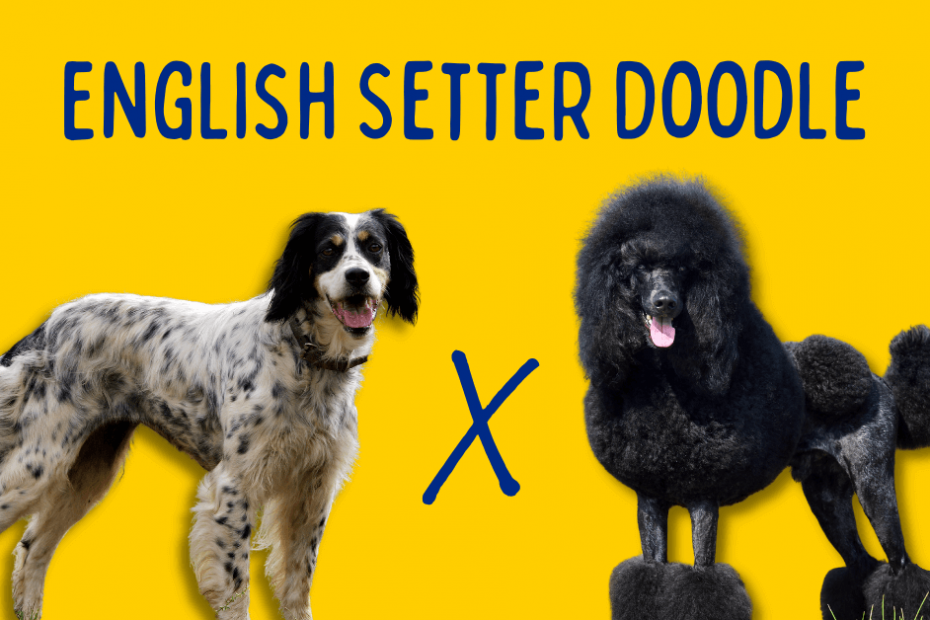The English Setter Doodle is a mix between an English Setter and a Poodle.
This athletic Doodle breed is a cross between two parents with a hunting history. The inherited traits from both breeds give this new mix a personality you don’t want to miss.
Maybe they are the perfect dog breed for you? Find out more below!
What is an English Setter Doodle?
An English Setter Doodle is a hybrid cross between an English Setter and Poodle. It’s considered a medium-sized designer breed, which means it’s not recognized by the American Kennel Club (AKC). The offspring of the cross results in a dog that’s a joy to own, trainable, intelligent, and focused.
The English Setter Doodle has higher energy and requires regular exercise but is happy to settle down after a play session. It’s also a good size for apartment life, but it is just as excited to live in a country with room to run.
Read on to learn more about this lovely hybrid and what to expect from owning one.
History of the Parent Breeds
The English Setter and Poodle are established breeds with distinctive physical traits and personalities. The following is a look at the origin and traits of each breed and what makes them wonderful dogs.
English Setter
The English Setter is a medium-sized hunting breed developed as far back as 500 years ago in Britain. The breed was developed to work game while being able to respond to the geographical challenges that are unique to the country.

The breed has two types, Laverack and Llewellin, with the Laverack breed being known as the larger type and the Llewellin known as the smaller hunting type. Each type has its own coat colors along with slightly different physical characteristics.
English Setters were developed from the crossing of Springer Spaniels, Spanish Pointers, and the large water spaniel. Indeed, the head of the modern English Setter retains a strong resemblance to its spaniel heritage even though thousands of generations have come and gone since the breed was settled.
The setter part of the breed’s name comes from the fact that the dog was trained to lie down or set when it spotted game birds, usually in bushes. The dog went ahead of the hunters to locate the birds, then lay down quietly so as not to spook the game. Once the dog set, the hunters came in with their nets and threw them over the bushes to trap the birds.
English Setters are bred to retain their instinct to stalk and alert the hunter to the presence of game without flushing the prey. They’ll alert the hunter by lying down or freezing in a pointing position with a level line from the nose’s tip to the tail’s end.
One owner says of her English Setter, Boone, that he is extremely prey driven and won’t hesitate to take the opportunity to seek out game. Many owners of English Setters have reported that their puppies display the seek-and-point instinct shortly after weaning.
The English Setter is a brilliant breed that’s easy to train, but this can also lead to stubborn streaks. They’re very loyal and, while known for being energetic, are happy to become couch potatoes after a round of vigorous exercise.
English Setters have an easy temperament, which makes them great family dogs. They can settle into apartment life as long as they get regular stimulation.
My experience with English Setters
My mom was obsessed with Terriers. So growing up, my family had Airedales and Welsh Terriers, and then eventually, we adopted a Miniature Schnauzer. On the other hand, my partner grew up with English Setters as the family dog.
I met her family’s English Setter, Luca, about a year after we met. He was incredibly sweet-tempered. I couldn’t help but be amazed at his regal coat. It was long, soft and full of color.

I enjoyed my time hanging out with him. I was amazed at how gentle he was. Unfortunately, he passed away due to old age.
Eventually, my partner’s family brought home a puppy English Setter, Remy. He was chock-full of energy and sass (like all puppies). He’s still young but displays the same gentle and sweet temperament that Luca did. He has the same beautiful coat as well.

I always love to visit her family so I can hang out with their English Setter. They are a wonderful dog breed and make an excellent mix with Poodles. As a Doodle owner, I would highly consider an English Setter-Poodle mix.
Poodle
The Poodle is famous for its hypo-allergenic hair coat and people-oriented nature. It comes in multiple sizes, making the breed perfect for people from all walks of life.
One Poodle owner states that one of her driving reasons for owning a Standard Poodle is its trainability and friendly nature. She also likes that he doesn’t drool and doesn’t bark often. Poodles are affectionate and friendly with people as a general rule.

They will alert if there’s a stranger at the front door, but if they know that the person is welcome in the home, they stand down.
The modern Poodle is viewed as something of a “frou-frou” breed because they were once popular among the wealthy. The teacup version of the Poodle is easily carried in a handbag, while the larger versions are primarily seen as an ornamental companion breed.
These opinions overlook that the Poodle was developed as a hunting breed and is very athletic despite being considered a dog for urban dwellers. The Poodle indeed has the temperament to handle apartment life, but it’s not a dog that thrives on little interaction.
Poodles are intelligent and energetic and need their fair share of exercise or play to feel good about themselves. They’re self-starters when it comes to entertaining themselves, but they love nothing more than a good romp with their human.
Poodle owners can enjoy these traits by enrolling them in dog agility classes or taking them to a doggy daycare where they can have rough and tumble time with other dogs.
The curly hair coat is the Poodle’s defining trait. It’s soft and silky but requires regular care and trips to the groomer.
Appearance
The English Setter and Poodle are similar in build and size but have distinctly different coats and colors. Combining the two breeds results in offspring with one of three different coat types, and solid coat colors dominate. Sometimes the offspring inherit the Belton coat of the English Setter, but the Poodle coat colors are more common.
The English Setter is known for a medium-to-long hair coat with a fringe that hangs from the abdomen, legs, and tail. Its dominant coat color is known as Belton, which refers to a ticked, roan, flecked, or spotted coat pattern. The Belton coat is similar to the Dalmatian coat in spotting and patterning.
Coat Type
The three coat types of the English Doodle include:
- Straight
- Wavy
- Curly
The straight coat is the least common, with wavy and curly being the most common. Offspring with a wavy or curly coat also has the hypoallergenic trait of the Poodle. The English Setter-Poodle mix with curly coats requires the same amount of grooming as their pure-bred Poodle parent. A straight coat also requires care but requires fewer trips to the groomers.
Coat Colors
Coat colors include white, blue, silver, grey, chocolate, apricot, creme, and black. A red coat sometimes shows up, as does a black and white ticked coat. The most common color is gold with white tips.
Size
The English Setter Doodle is considered a medium-sized dog that reaches the same height as its purebred parents. They come in sizes from small to standard, with most individuals falling in the standard height and weight range.
Height
The average height of the standard English Setter Doodle is 19 to 23 inches for females and 20 to 24 inches in height for males at the shoulder.
Weight
A standard-sized individual weighs anywhere from 45 to 60 pounds for females and 65 to 80 pounds for males.
Traits & Characteristics

English Setter Doodle’s Personality
Both breeds share similar temperaments and traits, making this a winning combination for someone who wants a highly-trainable dog that’s loyal, loving, and full of character. They can be trained to hunt like their purebred parents, are high-energy enough to keep up with kids, and are ready to relax once the day is done.
Remember that both breeds are prone to possessing a stubborn streak that requires careful training and positive reinforcement to overcome. The English Setter Doodle cross results in a dog that combines the best of both breeds and is one you’ll enjoy having around.
Common Health Issues
The English Setter Doodle cross results in something known as hybrid vigor. This is the potential to overcome genetic issues created by breeding similar individuals together for generations.
However, both Poodles and English Setters are prone to problems that include:
- Elbow dysplasia
- Hip dysplasia
- Hypothyroidism
- Epilepsy
- Osteochondrosis Dissecans
- Progressive Retinal Atrophy
- Deafness
- Addison’s disease
- Gastric torsion
- Eyelid issues
- Ear infections
It’s essential to ensure that the parents have good genetic backgrounds and are mainly free from genetic issues. Both parents should come from solid breeding stock and be free of these issues.
Any of these diseases and conditions can lurk in the background of the offspring, but the risks are significantly reduced with healthy parents.
Lifespan
The average lifespan of the English Setter-Poodle mix is anywhere from 10 to 15 years.
English Setter Doodle Grooming
The English Setter Doodle coat should be brushed daily to avoid tangles and mats that pull on the skin. A poodle needs a clip every 10-12 weeks, depending on how fast the hair coat grows.
Owners can clip their Poodles by themselves if they’re willing to put in the effort to learn, but the cost of a groomer may be worth paying to keep your Poodle looking good.
Final Thoughts
The English Doodle is a relatively new hybrid, but it makes sense when crossing purebreds. The English Setter and Poodle are established breeds with distinctive traits similar to each other.
Bringing them together results in a Doodle dog that delivers the best of both breeds. They are easy to train, great for hunting, and make for a perfect family dog.


